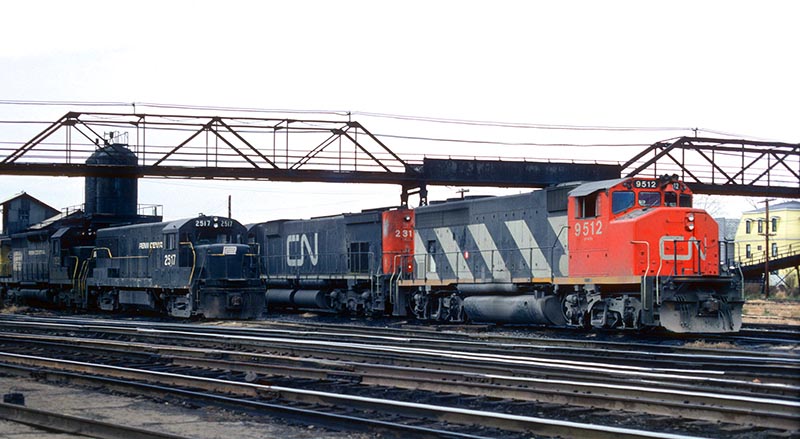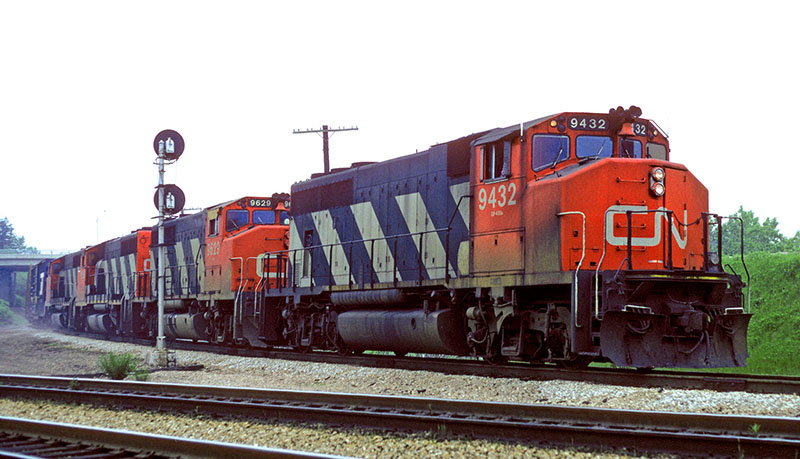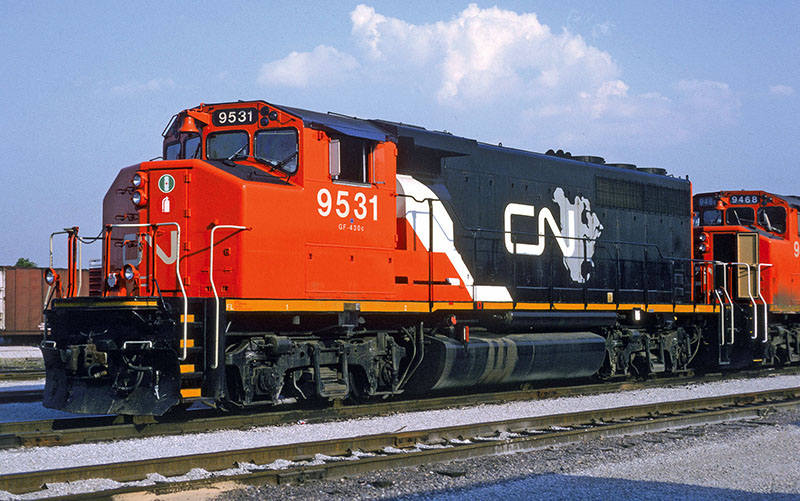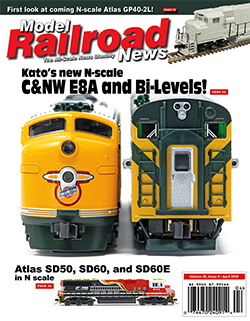In the mid-1960s, Canadian National (CN) focused a large portion of its motive power purchases on six-axle diesels. General Motors Diesel (GMD) and Montreal Locomotive Works (MLW) supplied approximately 350 new six-axle units to CN’s roster in the form of SD40s and M-630s. These heavy diesels saw use in mineral unit train operations that were gaining popularity during the 1960s. The road didn’t ignore four-axle power and B-B arrangement diesels joining CN’s roster in the latter part of the 1960s included GP40s and GP38ACs from GMD and MLW supplied its version of Alco’s C-424.
Wide-Nose GP40-2s
In the 1970s, CN purchased more than 120 SD40-2s and more than 100 GP38-2s. From those deliveries, the now-common face of the North American diesel arrived with wide-nose SD40-2W and GP38-2W models on the roster by 1974. A need for four-axle muscle to move important trains on CN’s eastern end prompted the arrival of the road’s GP40-2L. GMD’s GP40-2 production prior to Canadian National’s order amounted to a trio of examples for Toronto’s GO Transit. These GO Transit GP40-2s came with the wide front end appearance that CN received on its GP38-2 and MLW’s M-420 orders in the early 1970s. CN ordered 91 examples of GMD’s GP40-2L (9400–9490) in 1974 with the first 50 units being geared for the railroad’s “Express Freight” service with a top racing rate of nearly 80 mph.
The 41 other GP40-2Ls came with more typical 65 mph top speed gearing. Another 40 GP40-2Ls (9491–9530) came to the roster in 1974, followed by 102 additional examples (9531–9632) in 1975. The road went back for another GP40-2L order of 35 more (9633–9667); however, a slow economy resulted in a lack of need for the new power. Built in mid-1976 and delivered in 1977, the units found themselves with no immediate work and went into storage. The final tally of “bought new” GP40-2Ls was 268 for Canadian National. Though initially operated on the eastern parts of the system with bases of operation including Toronto, Montreal, and Winnipeg, the fleet worked system-wide eventually. In addition to racking up miles in Canada, CN’s GP40-2Ls ran on U.S. subsidiary Grand Trunk Western and leased out to Conrail. A few saw evaluation for their Positive Traction Control equipment on Rio Grande and on the test track of the Association of American Railroads, both in Colorado.

Canadian National 9512 and mate MLW M-630 are on Conrail tracks at Sayre, Pa., on October 30, 1976. CN’s GP40-2L fleet brought in revenue in lease service to railroads short on power, such as Conrail. — Don Jilson photo, Kevin EuDaly collection
A spotting feature of these mid-1970s GP40-2Ls included no dynamic brake blister on the long hood. The first units, which occupied CN’s GF-430a class, came with red nose and “zebra stripe” hoods. The scheme remained unchanged for the additional GP40-2L orders in the 1970s with classification moving forward a letter with successive orders. For example, the second round of GP40-2Ls (9491–9530) made up CN’s GF-430b class. In all, CN’s wide-nose GP40-2Ls took up GF-430a through GF-430g on the road’s books.
Modifications came in the mid-1980s that brought snow shields behind the cab to protect the air intake section on the long hood. Canada adopted ditch lights ahead of the U.S. and these pilot-mounted lights began to show up in the mid-1970s. They first saw use in western Canadian provinces but went system-wide as ditch lights became mandatory by 1990 in Canada. Around the same time ditch lights became the rule, CN’s GP40-2Ls saw their original horn location change. As-delivered, a bell was mounted on a bracket with the air horn cluster placed over it and was situated between the number boards over the forward cab windows. Later looks saw the air horn moved back on the long hood with placement just ahead of the three radiator fans.
The road picked up 10 GO Transit GP40-2Ls in the early 1990s. These additions more or less kept the roster number the same, as a few units were lost over the years to wrecks. In 1992, Canadian National’s “zebra stripes” gave way to a new rendition up CN’s GF-430b class. In all, CN’s wide-nose GP40-2Ls took up GF-430a through GF-430g on the road’s books.

Canadian National 9432 leads a four-unit consist of GP40-2Ls by Bayview Junction in Hamilton, Ontario. This example is an early version with no ditch lights, horn mounted over the bell up front, and no snow shields applied to the air intake behind the cab. — James E. Odell photo, Kevin EuDaly collection
Modifications came in the mid-1980s that brought snow shields behind the cab to protect the air intake section on the long hood. Canada adopted ditch lights ahead of the U.S. and these pilot-mounted lights began to show up in the mid-1970s. They first saw use in western Canadian provinces but went system-wide as ditch lights became mandatory by 1990 in Canada. Around the same time ditch lights became the rule, CN’s GP40-2Ls saw their original horn location change. As-delivered, a bell was mounted on a bracket with the air horn cluster placed over it and was situated between the number boards over the forward cab windows. Later looks saw the air horn moved back on the long hood with placement just ahead of the three radiator fans.
The road picked up 10 GO Transit GP40-2Ls in the early 1990s. These additions more or less kept the roster number the same, as a few units were lost over the years to wrecks. In 1992, Canadian National’s “zebra stripes” gave way to a new rendition of red up front with black back end that included an outline of the North American continent behind the road’s famous “wet noodle” CN on the long hood. This revised early 1990s livery, “CN North America,” featured a single wide, white, angled stripe that ran from the top of the cab’s back down the long hood side separating red and black on the body. More recently, CN GP40-2Ls could be seen in the road’s “URL scheme” with website address (www.cn.ca) presented below the “wet noodle” CN on the long hood.
Retirements for CN’s GP40-2Ls began in the mid-1990s and ebbed and flowed with traffic demand fluctuations. Second assignments for some CN GP40-2Ls included rebuilding into GP40PH-2s and use by Boston’s MBTA commuter passenger service. More GP40-2Ls left the roster and saw rebuilding in the U.S. by Livingston Rebuild Center and went back on the rails in Kansas City Southern’s gray livery. Other units leaving CN’s roster went on lease to several roads including Cape Breton & Central Nova Scotia, Goderich-Exeter Railway, Guilford, Huron Central, Pan Am Railways, and others.




